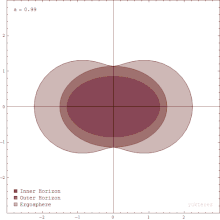Photon sphere
The photon sphere is a spherical boundary of zero thickness in which photons that move on tangents to that sphere would be trapped in a circular orbit about the black hole. For non-rotating black holes, the photon sphere has a radius 1.5 times the Schwarzschild radius. Their orbits would be dynamically unstable, hence any small perturbation, such as a particle of infalling matter, would cause an instability that would grow over time, either setting the photon on an outward trajectory causing it to escape the black hole, or on an inward spiral where it would eventually cross the event horizon.[115]
While light can still escape from the photon sphere, any light that crosses the photon sphere on an inbound trajectory will be captured by the black hole. Hence any light that reaches an outside observer from the photon sphere must have been emitted by objects between the photon sphere and the event horizon.[115] For a Kerr black hole the radius of the photon sphere depends on the spin parameter and on the details of the photon orbit, which can be prograde (the photon rotates in the same sense of the black hole spin) or retrograde.[116][117]
Ergosphere
Rotating black holes are surrounded by a region of spacetime in which it is impossible to stand still, called the ergosphere. This is the result of a process known as frame-dragging; general relativity predicts that any rotating mass will tend to slightly "drag" along the spacetime immediately surrounding it. Any object near the rotating mass will tend to start moving in the direction of rotation. For a rotating black hole, this effect is so strong near the event horizon that an object would have to move faster than the speed of light in the opposite direction to just stand still.[119]
The ergosphere of a black hole is a volume bounded by the black hole's event horizon and the ergosurface, which coincides with the event horizon at the poles but is at a much greater distance around the equator.[118]
Objects and radiation can escape normally from the ergosphere. Through the Penrose process, objects can emerge from the ergosphere with more energy than they entered with. The extra energy is taken from the rotational energy of the black hole. Thereby the rotation of the black hole slows down.[120] A variation of the Penrose process in the presence of strong magnetic fields, the Blandford–Znajek process is considered a likely mechanism for the enormous luminosity and relativistic jets of quasars and other active galactic nuclei.
Innermost stable circular orbit (ISCO)
In Newtonian gravity, test particles can stably orbit at arbitrary distances from a central object. In general relativity, however, there exists an innermost stable circular orbit (often called the ISCO), inside of which, any infinitesimal perturbations to a circular orbit will lead to inspiral into the black hole.[121]The location of the ISCO depends on the spin of the black hole, in the case of a Schwarzschild black hole (spin zero) is:
and decreases with increasing black hole spin for particles orbiting in the same direction as the spin.[122]
https://en.wikipedia.org/wiki/Black_hole


No comments:
Post a Comment